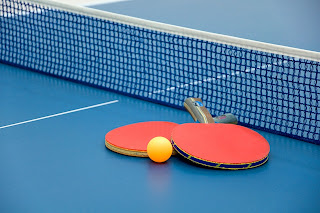
Table tennis, also known as ping-pong, is a sport in which two or four players hit a light ball, also called ping-pong ball, with small rackets from one side of a table to the other. The game takes place on a shared hard table divided by a net. The game is similar in principle to lawn tennis. The game is won when the player attains 11 points before the opponent. But when there’s a tie of 10 points, any player who leads by two points becomes the match-winner.
Table tennis is also called Whiff-Whaff, Indoor Tennis and Gossima.
According to the Olympic world library, over 10 million players participate in various table tennis tournaments each year.
According to research, table-tennis activates more parts of the brain than any other sport.
The first paddle was the back of a cigar box, and the first net was a stack of books. Surprisingly, the first ball was a champagne cork.
Doctors have recommended table-tennis to elderly patients to battle mental diseases such as Alzheimer’s and dementia.
The sport is the third largest sport in terms of participation after soccer and cricket.
Countries to have won medals during the Olympics in table-tennis are China, South Korea, Japan, North Korea, Germany, Sweden, France, Singapore, Yugoslavia, Denmark, Hong Kong, and Chinese Taipei.
The Guinness Book of World’s Record longest rally holder is Peter Ives and his son Daniel from England. Their rally took 32,000 total hits. The father and son who played for an incredible 8 hours, 40 minutes and 5 seconds, didn’t even stop for a bathroom break.
Table-tennis is one of the first sports to sell out during the Olympics, including during the 1996 Atlanta Olympics.
The longest table tennis point was played for 2 hours and 12 minutes, and it happened in the hard bat era.
The North American Olympic Team has typically consisted of players ranked in the top 100, top 200, or top 300 in the world ranking.
The first country to dominate the sport was Hungary, and also it was in the hard bat era.
According to International Table Tennis Federation coaching education, it takes 15 years of serious training to reach the level of the North American Olympic Team (a rating of 2,700 or world top 100-300) and 20 years to be at the very top in the world (a rating of 2,900 or world top 10).
Table-tennis was first debuted in the Olympics in the year 1988.
According to a study done by the Chinese national team, the maximum rotations during play of a 40 mm ball is around 8,000 rotations per minute (rpms).
China leads when it comes to the number of table tennis players. It has 100 million table tennis players.
The balls used until the 2000 Olympics were 38 mm in diameter and those balls reached a maximum of 9,000 rpms.
The world’s recognized body for the sport is known as the International Table Tennis Federation (ITTF), and it was created in 1926. The body has 226 member countries.
China has 40,000 professional table-tennis players paid by the government to practice full-time.
Janove Walder is considered the best player of the sport. He is from Sweden. He has won more medals than any other player. And he’s commonly referred to as “Mozart of table tennis.”
Nearly every country in Europe has more registered table-tennis players than tennis players.
A modern table tennis table is 76 cm high, 1.525 m wide, and 2.74 m long. On the other hand, the net is 15.25 cm high while the ball’s diameter is 40 mm.
Countries such as Germany have close to 1 million table-tennis players.
From 1930 to 1950, the Soviet Union banned the sport because the authorities related it to various eye conditions. But after 1950, the ban was rebuffed.
Portugal became European Champion in 2014 for the first time by defeating defending champion Germany in the finals.
According to the game rules, when the ball is dropped from a height of 30.5 cm, it should bounce within 24-26 cm.
The first patent for table-tennis was done in 1891 by Charles Baxter in England.
From 2015, the table tennis ball is made from plastic instead of celluloid, and the colors of the ball are either orange or white, along with a matte finish. The table’s color determines the choice of the ball.
Ping-Pong Diplomacy was used by China and US in 1971 to develop diplomatic relations where friendship matches took place throughout the US between the two countries’ national teams.
Professional players can smash the ball at a speed that exceeds 160 km per hour.
London hosted the first official World Championships in 1926.
The most ball hammering record is 173 times in 60 seconds, and this was done by Jack Bellinger and Lisa Lomas in 1993.
In 1933, the United States Table Tennis Association, now called USA Table Tennis, was formed.
The international regulations state that the game’s sphere (ball) should have a mass of 2.7 grams.
In the 1950s, paddles that used a rubber sheet combined with an underlying sponge layer changed the game dramatically, introducing greater spin and speed.
Until 2000, the table tennis sport was played for 21 points; from 2000, the points were reduced to 11.
Table Tennis was first included in the Olympics in the year 1998 during Seoul Olympics.
Table Tennis FAQs: Get into the Ping Pong Groove
Table tennis, also known as ping pong, is a fast-paced and exciting sport enjoyed by people of all ages and skill levels. Here are some FAQs to answer your questions and get you started:
Basic Gameplay
-
What is the objective of table tennis? The objective of table tennis is to hit the ball over the net and onto your opponent’s side in a way they cannot return it. Points are scored by either forcing your opponent to miss a shot, hitting the ball out of bounds, or through service errors.
-
How is a game played? A game is played to 11 points, with a player needing to win by two points. For example, a game can end 11-9, 12-10, or even 23-21. Matches typically consist of the best of three or five games.
-
How does serving work? The serve must start with the ball held in the open palm behind the end of the table. The ball is tossed at least 6 inches straight up and then struck on the way down. The serve must bounce once on your side of the table and then travel over the net to your opponent’s side.
-
What are the basic strokes? There are two main forehand and backhand strokes used to hit the ball. The forehand stroke involves swinging the paddle forward, while the backhand involves turning your body slightly and swinging the paddle across your body. These strokes can be used with variations in speed, spin, and placement to create offensive or defensive shots.
Equipment
-
What kind of paddle should I use? Paddles come in various shapes, sizes, and materials. For beginners, a pre-made paddle with a slower blade speed and grippy surface is recommended. As skills develop, players can explore paddles with different speeds, spins, and weight characteristics to suit their playing style.
-
What size ball is used? A standard table tennis ball is 40 millimeters in diameter and made of celluloid or newer, more durable, ABS plastic. The ball is white or orange in color.
-
What kind of table do I need? A regulation table tennis table is 2.74 meters long, 1.525 meters wide, and 76 centimeters high. The top surface is a hard, low-friction material that provides a consistent bounce for the ball. Tables can be foldable for easy storage.
Learning and Playing
-
Where can I learn to play table tennis? Many community centers, recreation centers, and some gyms offer table tennis classes or have tables available for public use. You can also find clubs or groups dedicated to table tennis in your area. There are also numerous online resources and instructional videos to help you learn the basics.
-
Is table tennis a good workout? Absolutely! Table tennis provides a great cardiovascular workout, improving stamina and agility. It also requires hand-eye coordination, reflexes, and strategic thinking.
-
Can I play table tennis by myself? Yes! There are table tennis robots available that can shoot balls at you to practice your strokes. You can also practice against a wall to hone your technique.
-
How can I find people to play with? Look for table tennis clubs or groups in your area. Many online platforms connect table tennis players to find partners with similar skill levels.
These FAQs provide a starting point for your table tennis journey. Whether you’re looking for a casual game or a competitive challenge, table tennis offers a fun and rewarding way to get active and develop new skills. So, grab a paddle, find a table, and get ready to experience the thrill of ping pong!










The blog post presents a balanced view of the subject matter, considering different perspectives and providing well-supported arguments.